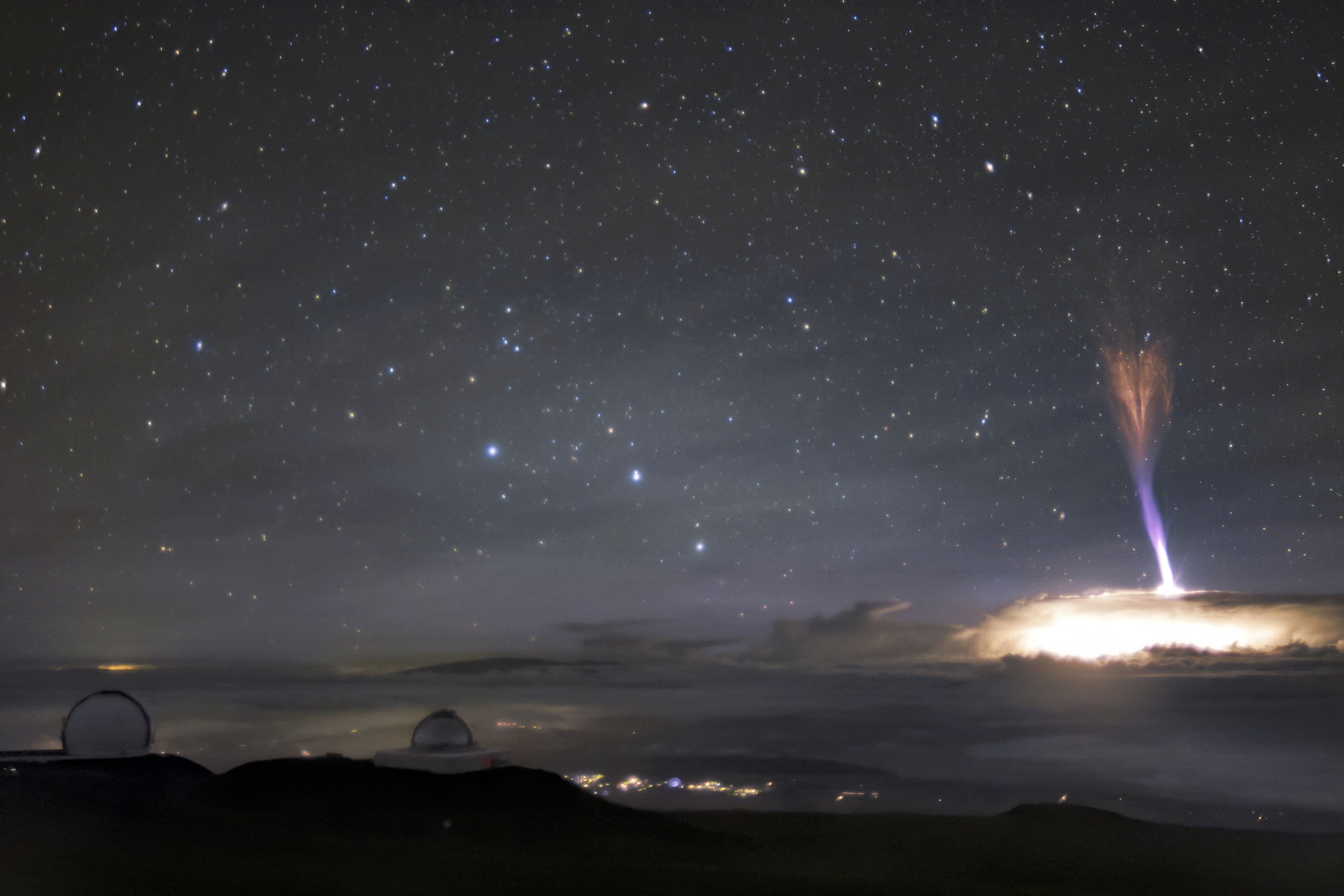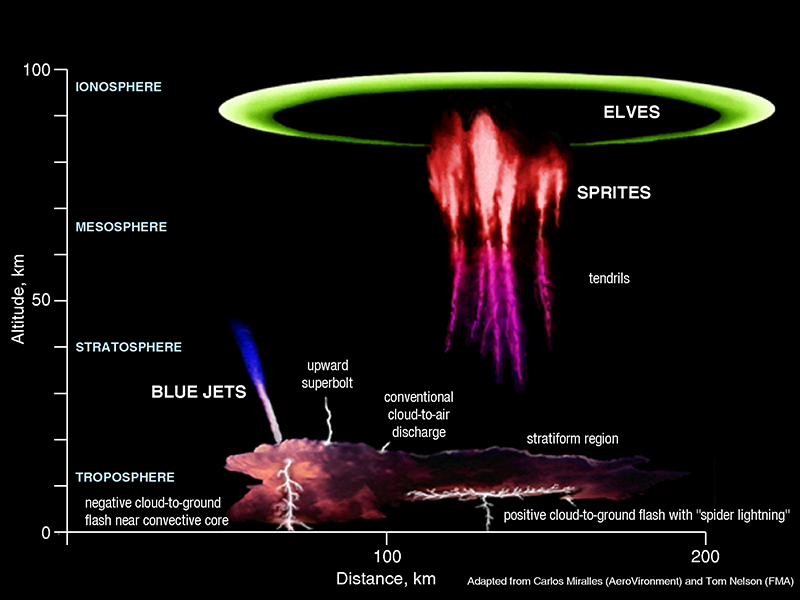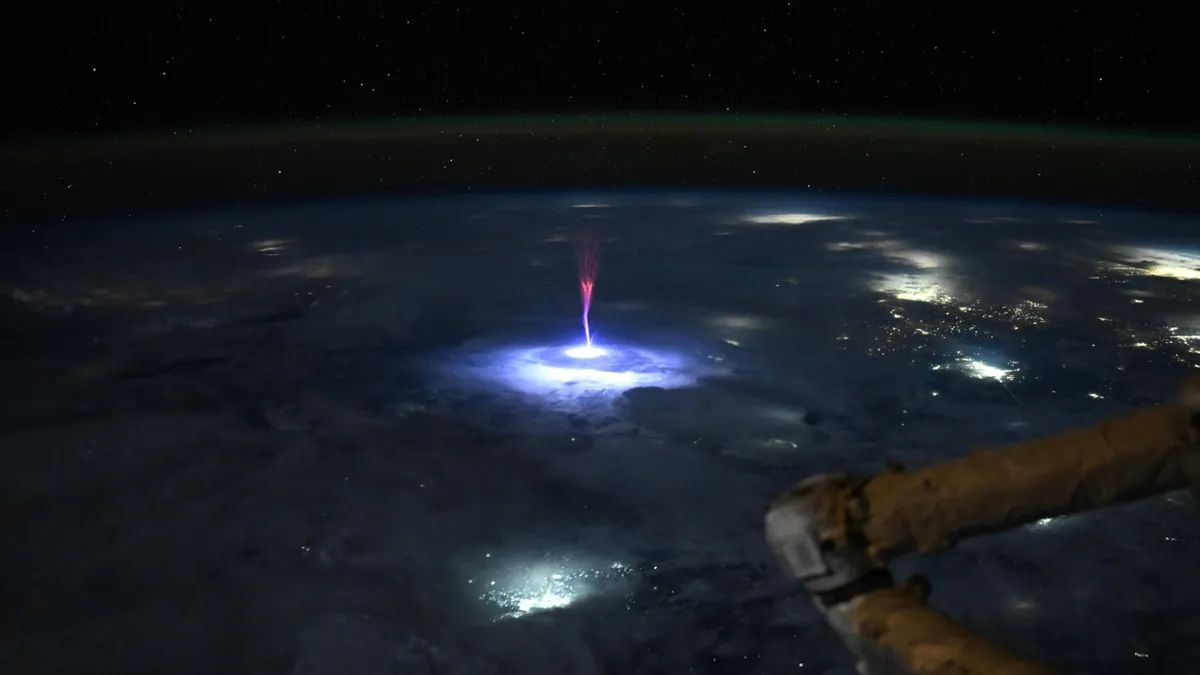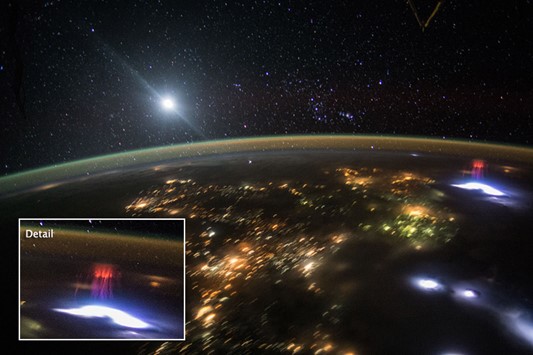
Credit: International Gemini Observatory/NOIRLab/NSF/AURA/A. Smith, CC BY 4.0, via Wikimedia Commons
Background
Synopsis: High above thunderstorms, fleeting bursts of light create a celestial light show rarely seen by the human eye. These mysterious phenomena not only add to the wonder of Earth’s electrical systems but also hold valuable scientific insight into atmospheric chemistry.
- Imagine that you are an airline pilot, flying home for the holidays and keeping an eye on a large thunderstorm below. Out of the corner of your eye, you see a red flash of light. Was that Santa’s sleigh? Rudolf’s nose? Or just a trick of the eyes?
- It was real but it wasn’t any of those. What you caught a glimpse of was a sprite—not the mischievous kind from folklore, but an electrified, fleeting ghost of the atmosphere.
- Typical lightning strikes below storm clouds, while sprites are a type of fleeting glow that occur high above thunderstorms, in the upper atmosphere.
- Scientifically known as transient luminous events (TLEs), these lightning related phenomena are bright and colorful and occur at faster-than-lightning speeds.
- Unlike twinkling lights on a tree, these atmospheric flashes appear and vanish so quickly that they seem like ghostly mirages of the upper atmosphere.
- Eyewitnesses reported these unique flashes of light as far back as the 1700s, but it wasn’t until a sprite was documented on video tape in 1989 by researchers at the University of Minnesota, that scientists started to give them attention.
- Their brief duration and location above storms made them nearly impossible to observe with the naked eye. Only with the advent of high-speed photography and satellite technology have scientists been able to study them in detail.
- Lasting only milliseconds, these incredibly fast types of lightning have now been recognized in three distinct forms.
- Sprites—red flashes resembling jellyfish or tendrils
- Blue Jets—electric-blue columns shooting up from storm clouds
- ELVES—expanding rings of light, appearing like a disk just above the ionosphere; Expanding Light emission from Very Energetic Sources.
- Together, these radiant images provide the ultimate natural color palette for holiday lights.

Large thunderstorms can produce lightning but may also create sprites, blue jets and ELVES if the conditions are just right.
Credit: NOAA
- An early episode of EarthDate describes in detail how lightning forms inside storm clouds.
- Lightning occurs when friction between ice crystals and water droplets within a storm cloud causes a separation of electric charges. This leads to an accumulation of negative charges in the lower part of the cloud and positive charges in the upper part.
- The buildup of these electric charges creates a strong electric field between the cloud and the ground or between different regions within the cloud.
- When the electric field becomes strong enough, it overcomes the air’s resistance, causing a sudden discharge of electricity in the form of lightning. These discharges can occur within the cloud or between the cloud and the ground.
- TLEs are a result of the electric fields and charged particles associated with thunderstorms.
- Sprites aren’t just for Christmas fairy tales—these real-life flashes of red light dance high above thunderstorms, lighting up the heavens like celestial ornaments.
- Sprites occur 30–55 mi (50–90 km) above Earth, far higher than ordinary lightning.
- They are triggered by positive cloud-to-ground lightning discharges, altering the electric field above storms.
- The sprites take on various forms known as columns, carrots or jellyfish, depending on atmospheric conditions.
- Jason Ahrns was a graduate student at the University of Alaska when he got the chance to see and photograph a sprite. He said, “Knowing it and seeing it for yourself are two different things.” Even when “flying 120 miles away from the storm and the sprite is still tall enough to fill my vision from top to bottom, that leaves an impression!”
- More recently, astronaut Nicole Ayers captured a spectacular sprite from aboard the International Space Station while photographing a thunderstorm over Europe. The glowing red tendrils stretched above the clouds, visible even from orbit. This rare and vivid image offers scientists a unique vantage point for studying TLEs from space.

A red sprite flashes above a thunderstorm over Mexico and the southern U.S., captured by astronaut Nicole Ayers from the ISS.
Credit: Nicole Ayers/NASA
- Blue jets emerge from the tops of storm clouds and shoot up into the stratosphere.
- They are caused by imbalances between the cloud and the upper atmosphere, creating a rush of electrical energy.
- Unlike sprites, blue jets do not require cloud-to-ground lightning to occur.
- ELVES are not the elves busy in Santa’s workshop, but ELVES in the sky—Expanding Light emission from Very Energetic Sources.
- These occur when electromagnetic pulses generated by lightning excite nitrogen molecules in the air.
- ELVES occur in the ionosphere, which is about 62 mi (100 km) up and appear as an outward spreading, near-instantaneous ripple. This ring of light can often expand hundreds of kilometers outward.

Sprites and other TLEs are visible from the International Space Station (ISS). Crew members capture these events using wide focal lengths and time-lapse photography.
Credit: NASA
- Sprites aren’t just for Christmas fairy tales—these real-life flashes of red light dance high above thunderstorms, lighting up the heavens like celestial ornaments.
- TLEs are fascinating and peculiar sight to behold, but what might we learn from them and their effect on Earth?
- TLEs provide a window into the dynamic electrical system of Earth. By studying TLEs, scientists can further their understanding of how electrical energy moves within the atmosphere.
- The electrical charges play a role in atmospheric chemistry and potentially greenhouse gas formation.
- Ordinary lightning plays an important role in the process of nitrogen fixation, converting nitrogen in the air into nitrogen oxides needed by plants. This ground lightning produces little to no nitrous oxide (N2O) and ozone (O3).
- The production of the upper atmosphere lightning TLEs, however, form considerable amounts of nitrous oxide and ozone in laboratory simulations.
- Although nitrous oxide, methane and CO2 are all trace gases in the atmosphere, combined making up an extremely small percentage of the atmosphere (<0.25%), nitrous oxide is nonetheless a potent greenhouse gas.
- Scientists are working to both identify and quantify the sources and sinks of nitrous oxide to better understand how they might impact climate.
- To see a TLE requires being in the right place at the right time with the right equipment.
- The best viewing locations are high-altitude regions with frequent thunderstorms such as the U.S. Great Plains, Argentina and Central Africa. Observing from airplanes or high mountains increases the chances of spotting them.
- The best visibility of TLEs occur on dark, moonless nights when there are clear skies above a thunderstorm.
- TLEs happen in the blink of an eye so you would need a high-speed camera to capture an image of one. Some lucky observers have accidently caught sprites on long-exposure photography while filming distant lightning storms.
- While thunderstorms are less common in winter, they still happen especially in coastal regions or during intense snowstorms with thunder and lightning known as thundersnow.
- Could holiday travelers catching flights in December get a rare view of a sprite?
- If you would like to learn more and even be on the watch for these magical events, consider joining or following Spritacular.org, a citizen science program supported by NASA that seeks to collect observations and build a database of TLEs.
- TLEs are a fleeting, otherworldly glimpse into Earth’s atmospheric forces. Though short-lived, they have profound implications for space weather, satellite technology and even climate science.
- So, this holiday season, as you enjoy twinkling lights on rooftops, remember that nature has its own dazzling display—one that requires just the right moment to witness.
Episode script
You may remember that opposite electrical charges attract.
If a positive charge builds up, it seeks to connect to a negative charge, to reach equilibrium.
This is what creates lightning. As explained in a prior episode, it’s generated by the static electricity of water vapor and ice molecules rubbing against each other. Billions and billions of molecules can produce a whopping charge.
Positive and negative charges build within the cloud, but they’re separated by air, which is a poor conductor. But once the charges are large enough, they overcome that resistance and connect as lightning—within the cloud or to Earth.
Sometimes, though, a powerful charge builds in the top of the cloud, and rather than striking down, it seeks equilibrium by going … up!
The charge leaves the top of the cloud and explodes into the atmosphere in what’s called a Transient Luminous Event, or TLE.
There are several types, called Sprites, Blue Jets and Elves. That’s ELVES—Expanding Light emission from Very Energetic Sources. They take the shapes of columns, glowing rings or giant ‘jellyfish.’ But they last just a fraction of a second.
Eyewitnesses saw TLEs 300 years ago. But it wasn’t until the advent of super high-speed video that scientists could capture their remarkable images to study them.
Another reminder that there are still many things to discover, right here on—or just above—Earth.

